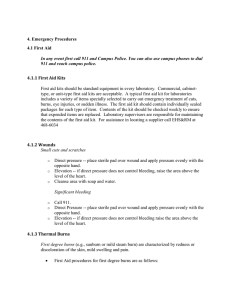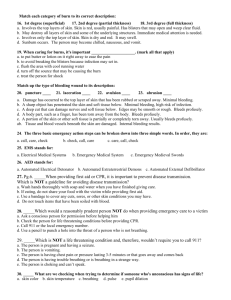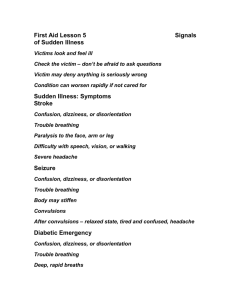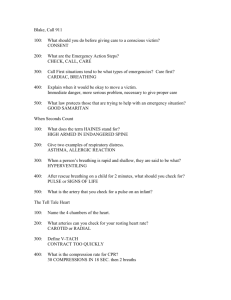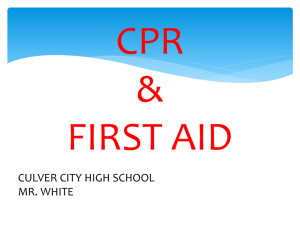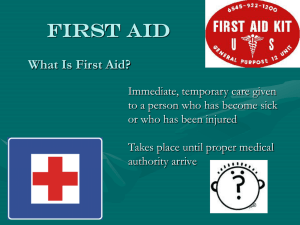Basic First Aid For Schools - Kankakee County Health Department
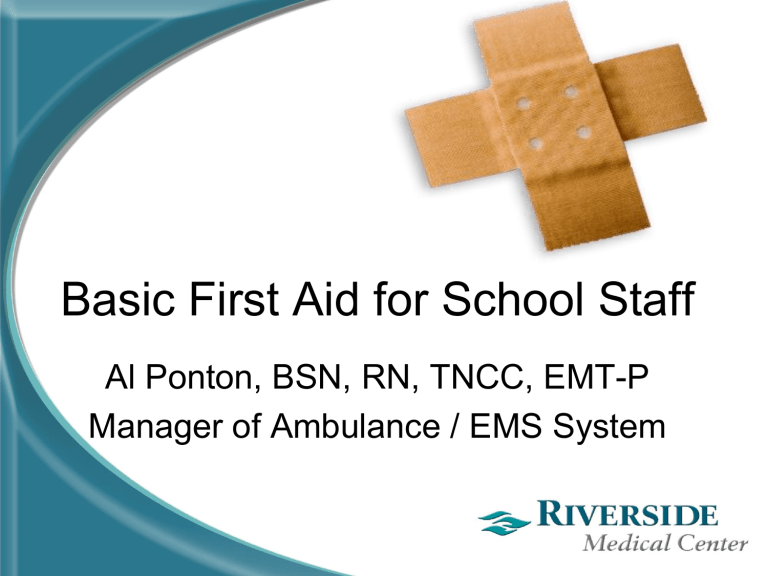
Basic First Aid for School Staff
Al Ponton, BSN, RN, TNCC, EMT-P
Manager of Ambulance / EMS System
Session Objectives
• Chain of Survival
• What is First Aid?
• Scene Survey
• Initial Assessment
• Identify proper procedures for a variety of medical emergencies
• Assist in administering first aid when the need arises
• Do no further harm
Prequiz: True or False
• After an accident, immediately move the victim to a comfortable position?
• If a person is bleeding, use a tourniquet?
• Signs of a heart attack include shortness of breath, anxiety, and perspiration?
• All burns can be treated with first aid alone; no emergency medical attention is necessary?
Help!!!! Emergency!
Minutes could make a difference
Chain of Survival
Early
Access “911”
Early
First Aid/CPR
You
Early
Defibrillation
Early
Advanced
Care
EMS Arrival
Basic First Aid
What is First Aid?
• The immediate care given to an injured or suddenly ill person.
• Four basic rules
• DOES NOT take the place of proper medical treatment.
• Legal Considerations
Assessing the Scene
Evaluate the scene
Assess safety
Prioritize care
Check for medical alert tags
Do head-to-toe check
Move only if necessary
Initial Assessment
• Goal of the initial assessment:
– Visually determine whether there are life-threatening or other serious problems that require quick care.
– Determine if victim is conscious - by tap and shout.
Check for ABC as indicated:
• A = Airway?
– Check for breathing
• B = Breathing? – Look and listen
• C = Circulation?
– Check for signs of circulation.
Asthma (Known Asthmatic)
• Signs of distress will be labored breathing, flaring of the nostrils, audible wheezing, cough, shortness of breath which results in rapid breathing.
• Asthmatic students who carry an inhaler should have it immediately available.
• Use inhaler ASAP
• Have the student lean forward with elbows on knees
• Call 911 if difficulty breathing continues after treatment and/or the student has trouble talking.
Bleeding Control
Stop the flow of blood
Wear gloves
Cover the wound
Apply pressure
If a body part has been amputated, put it on ice
Nosebleeds
• Sit student down
• Pinch nostrils, lean forward and breathe through the mouth.
• Pressure should be applied for at least 10 minutes.
• No nose blowing
Fainting / Dizziness
• Check for breathing
• Administer CPR if necessary.
• Call 911 if more than a few minutes.
• If conscious, lay the victim down with feet elevated.
Shock
• Shock refers to circulatory system failure that happens when insufficient amounts of oxygenated blood is provided for every body part. This can be as the result of:
– Loss of blood due to uncontrolled bleeding or other circulatory system problem.
– Loss of fluid due to dehydration or excessive sweating.
– Trauma (injury)
– Occurrence of an extreme emotional event .
Shock Cont.
• What to Look For
– Altered mental status
• Anxiety and restlessness
– Pale, cold, and clammy skin, lips, and nail beds
– Nausea and vomiting
– Rapid breathing and pulse
– Unresponsiveness when shock is severe
Anaphylactic Shock
• Give the victim prescribed medication
• Call for help ASAP
• Start CPR if necessary
Bites and Stings
• Insect stings and bites
– What to Look For:
• Check the sting site to see if a stinger and venom sac are embedded in the skin.
– Bees are the only stinging insects that leave their stingers and venom sacs behind.
– Scrape the stinger and venom sac away with a hard object such as a long fingernail, credit card, scissor edge, or knife blade.
• Reactions generally localized pain, itching, and swelling.
• Allergic reaction (anaphylaxis) occurs will be a life threatening.
Bites and Stings Cont.
• Insect stings and bites Cont.
– What to Do:
• Ask the victim if he/she has had a reaction before.
• Wash the sting site with soap and water to prevent infection.
• Apply an ice pack over the sting site to slow absorption of the venom and relieve pain.
– Because bee venom is acidic, a paste made of baking soda and water can help.
• Seek medical attention if necessary.
Bites and Stings Cont.
• Tick bites
– Tick can remain embedded for days without the victim’s realizing it.
– Most tick bites are harmless, although ticks can carry serious diseases.
– Symptoms usually begin 3 to 12 days after a tick bites.
Burns
• Burns have been described as:
– First-degree burns
– Second-degree burns
– Third-degree burns
Burns Cont.
• First-degree burns (Superficial)
• Only the skin’s outer layer (epidermis) is damaged.
– Symptoms include redness, mild swelling, tenderness, and pain.
– Usually heals without scarring.
• What to Do:
– Immerse in cold water 10 to 45 minutes or use cold, wet cloths.
» Cold stops burn progression
» May use other liquids
– Aloe, moisturizer lotion
Burns Cont.
• Second-degree burns (Partial Thickness)
– Epidermis and upper regions of dermis are damaged.
• Symptoms include blisters, swelling, weeping of fluids, and severe pain.
– What to Do:
• Immerse in cold water / wet pack
• Aspirin or ibuprofen
• Do not break blisters
• May seek medical attention
Burns Cont.
• Third-degree burns (Full Thickness)
– Severe burns that penetrate all the skin layers, into the underlying fat and muscle.
• Symptoms include: the burned area appears gray-white, cherry red, or black; there is no initial edema or pain (since nerve endings are destroyed)
– What to Do:
• Usually not necessary to apply cold to areas of third degree
• Do not apply ointments
• Apply sterile, non-stick dressings (do not use plastic)
• Check ABC’s
• Treat for shock
• Get medical help
Heat Exhaustion
• Move to cool place
• Lay victim down
• Elevate feet
• Loosen clothing
• Give fluids
• Apply cool compresses
Heatstroke
• Immediately call 911
• Cool the person down
• Monitor
Broken Bones
• There are two categories of fractures:
– Closed (Simple) fracture
• The skin is intact and no wound exists anywhere near the fracture site.
– Open (Compound) fracture
• The skin over the fracture has been damaged or broken.
• The wound may result from bone protruding through the skin.
• The bone may not always be visible in the wound.
Broken Bones Cont.
• What to Look for:
– General signs and Symptoms:
• Tenderness to touch.
• Swelling.
• Deformities may occur when bones are broken, causing an abnormal shape.
• Open wounds break the skin.
• A grating sensation caused by broken bones rubbing together
– can be felt and sometimes even heard.
– Do not move the injured limb in an attempt to detect it.
• Loss of use.
Broken Bones Cont.
• Treatment:
– If bleeding at the site, stop bleeding by using direct pressure directly on the wound with sterile or clean bandage
– Immobilize the areas; Immobilize the extremity above and below the joint.
– Apply ice to extremity to decrease swelling.
– Check for a pulse distal to the extremity.
Eye Injuries
• Splashes
• Particles in the eye
• Blow to the eye
• Cuts near the eye
• Penetrating objects
Epileptic Seizures
• Remove victim from hazards
• Check for breathing
• Nothing in the mouth
• Keep comfortable
• Call 911
Heart Attack
• Heart Attack – Usually that happens when one of the coronary arteries is blocked by an obstruction or a spasm.
– Signs and symptoms of a heart attack include:
• Pressure in chest, fullness, squeezing, or pain that lasts more than a few minutes or that goes away and comes back.
• Pain spreading to the shoulders, neck, or arms.
• Chest discomfort with lightheadedness, fainting, sweating, nausea, or shortness of breath.
Heart Attack
• What to Do:
– Call EMS or get to the nearest hospital emergency department with 24-emergency cardiac care.
– Monitor victim’s condition.
– Help the victim to the least painful position, usually sitting with legs up and bent at the knees.
• Loosen clothing around the neck and midriff.
– Determine if the victim is known to have coronary heart disease and is using nitroglycerin.
– If the victim is unresponsive, check ABCs and start
CPR, if needed.
Not Breathing
• Administer CPR:
– Lay the victim on their back.
– Give chest compressions.
– Continue until EMS personnel arrive on scene.
Choking
• Ask the person to speak or cough.
• Perform abdominal thrust.
• Goes unresponsive-CPR.
E
X
E
R
CI
S
E
• Match the problem with the correct first-aid procedure
Bleeding
Choking
No Breathing
Shock
Heart Attack
CPR
Elevate feet
Keep victim still
Direct pressure
Abdominal thrusts
Summary
• Medical emergencies can happen anytime.
• Assess the situation
• Act quickly and calmly
• Ask for permission to help if possible unless the person is unconscious, then use “implied consent”
• Call for help when necessary
• Stabilize the situation before help arrives
• Try to remain calm and do not panic
